
| Murou Village has more than a thousand years
of history as a holy place of the Murou temple, Ohno temple which
is the largest temple in Japan, and a precious and cultural artifacts
such as the "Magaibutsu". In addition,this nature is abundant in this
beautiful village with plentiful mountains,valleys, and forests. Situated
in the northern Uda County of eastern Nara prefecture its image is
one of a cultural village. The cultural heritage of Murou village
is conveyed today through its lineage and history. |

 |
Ohnodera Temple |

 |
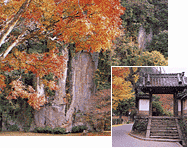
Magaibutsu

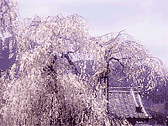
Drooping Cherry Tree (Spring)
|
 |
Related to the Murou temple since ancient times, it has come to
be called as the western gate of the Murou temple. Opposite to the
temple is the famous Ohno Temple Magaibutsu. Built in the Kamakura
era at the request of emperor Gotoba its total height is 14 meters.
In the spring the temple ground is a beautiful site as the blossoms
bloom on the drooping cherry trees which said to be 200 years old.
The statue of Jizo(a guardian deity of children) in the main temple
is also an important national treasure as its title "The Sacrifice"
suggests tells the story of the saving of an innocent young girl from
punishment of burning at the stake.

@
5 minute walk from Kintetsu Railway (Kinki Nippon Railway)
Murouguchi-Ohno station |

 |
Muroji Temple |

 |
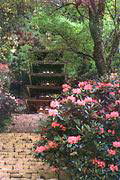
Five-Storied Pagoda and Riotous
 |
 |
Muroji Temple, built in the 8th century, stands in a mountain valley, in the midst of a cryptomeria grove . Its five-storied pagoda is the smallest outdoor pagoda in japan. The Kondo(Main Hall)which stands at the top of Muroji's long stone stairway presents to the visitor a variety of elegant and graceful expressions, depending on the season, set off against a backdrop of vivid greens in spring and summer, or of blazing reds and yellows in
autumn. The Mirokudo Hall houses such works as the seated Shaka Nyorai figure, a masterpiece exemplifying the distinctive flavor of early
9th-century Buddhist art. |
 |
The visitor who comes to this temple in May, when rhododendrons are in riotous bloom, or in October and November, when the autumn leaves from a gorgeous canopy overhead, will find it uncommonly beautiful.
From Kintetu Muroguchi-Ono Station:Board the bus, get off at the "Muroji-mae" bus stop, and wark 5 minutes to the temple. |
 |
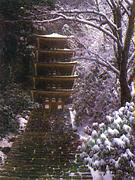
Five-Storied Pagoda in Winter |
 |
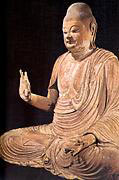 |
 |
Sedentary statue of Shaka-Nyorai of the Muroji Temple
This wooden sedentary statue of Buddha is outstanding among a number of Buddhist images kept at the temple, which possesses a fine collection of early Heian Period art works. The statue is said to be typical of 9th Century sculpture. |

 |
Tour of the Murou Village. |

 |

(Note: On Saturdays, Sundays, and holidays during flower-viewing season [late April and early May], express buses leave Muroji Temple about 1 times per how.j
|
|
